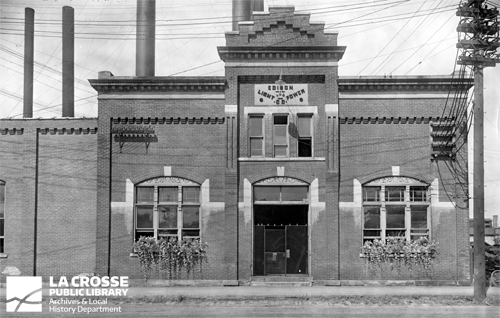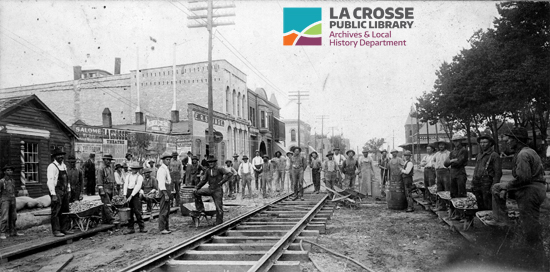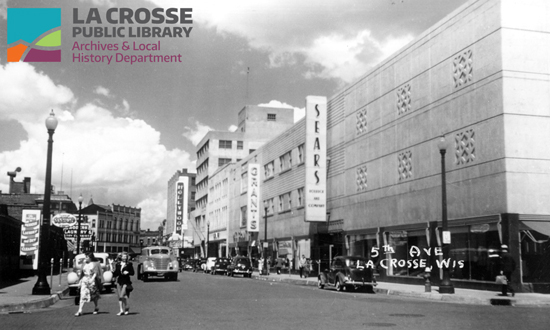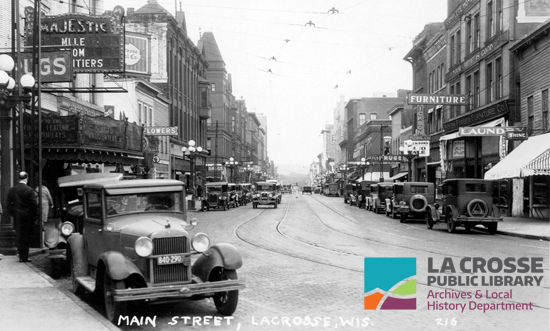
City Heat: A Forgotten Utility
(written by Anita Taylor Doering, Archives staff)
City heat was a separate centralized heating system that was distributed to south side La Crosse customers for 70 years from 1899-1969. It originated from the Edison Light and Power Company on 2nd Street South between King and Jay streets. Frederick A. Copeland, for whom Copeland Park is named, served on the board of the Edison Light and Power Company. He is credited with presenting the idea to La Crosse customers based on observations he had made at Logansport, Indiana.

Standing at 2nd Street between Jay and King streets (412-416 So. 2nd Street), the Edison Light and Power Company building pictured here is thought to date from the late 1880s. It was the source of La Crosse’s “city heat.”
During moderate weather, hot water was dispersed at 160 degrees Fahrenheit from the Edison plant through underground pipes. This hot water would then be hooked up to a building’s radiator system, and would avoid the need for that structure to have its own heating system. The temperature was raised one degree to each drop of one degree of outside temperature, until it reached 200 degrees, the point at which the hot water would create steam. After the water had been circulated through the system, it returned to the plant in a separate pipe, with an average loss of about 32 degrees.

Pictured here is a group of men who are paving North 3rd Street with bricks, circa 1900.
An 8-inch main pipe was laid on King Street to a point between 6th and 7th streets. 14th Street was the eastern edge of the hot water heating system. Extensions to the system were made in 1906 and 1913-14. The streets at that time were largely unpaved when the system was installed. The pipes were laid in wooden boxes and were upgraded to concrete in 1937.

The Edison Plant of the Wisconsin-Minnesota Light and Power Company is shown here after a fire on May 25, 1916. In this scene, the telephone lines are being rewired.
By this time the system counted 302 consumers, including the majority of the downtown buildings, apartments and residences. Dr. Frank Hoeschler’s 5th Avenue buildings were all designed to make use of city heat.
The Edison Plant was eventually purchased by Northern States Power Company (NSP). Fast forward to the 1960s and NSP wanted to raise city heat customers’ rates by 19% in 1963. The utility contended that it lost 65 customers of its city heat service over the previous five years while costs increased. NSP also foretold that “pipes carrying the hot water to NSP city heat customers are deteriorating and [are] uneconomical to replace.”

The Frank J. Hoeschler Company was the largest consumer of city heat by the 1960s. Many of the Art Deco and Art Moderne style buildings were built by Hoeschler in the late 1920s and early 1930s and were reliant on city heat. Hoeschler had city leaders rename 5th Street to 5th Avenue after New York City's exclusive shopping area in hopes of attracting shoppers to his retail stores.
In 1966, NSP announced plans to shut down the city heating system. Of the 237 customers, 65 of them prepared to fight the plan. Led by the single largest consumer, the F. J. Hoeschler Company, the nine-member committee was comprised of some of La Crosse’s biggest businessmen, including elected chairman James A. “Jake” Hoeschler. The group contended that abandoning city heat would result in large costs for downtown building owners. Not only would furnaces need to be installed, but fire walls, fire escapes, and chimneys. The committee also argued that there weren’t enough heating contractors available locally to do the work in a timely manner, especially in the large-scale buildings.

Main Street in the early days of city heat, circa 1910s-1920s
Despite the grass roots fight, the best the committee managed to do was delay the shutdown date. In the end, the Wisconsin Public Service Commission authorized the shutdown to happen July 1, 1969. NSP did agree to give subsidies based on a building’s square footage of heating radiation, chimney and firewall installations, and engineering fees, but customers still complained of the small amounts received.
While La Crosse no longer has a centralized heating system, there are a number that exist both in the United States and abroad, most focused on centralized business districts. While the oldest continuously operating system is that of Denver from 1880, New York City claims to have the largest commercial district heating system in the United States. It has operated continuously since 1882 and serves Manhattan Island. Just as the curtain was coming down on La Crosse’s city heat system, Milwaukee started one for its central business district in 1968. The city realized an immediate improvement in air quality in that vicinity.

